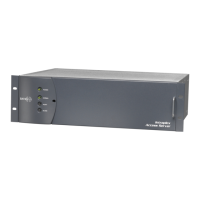ACS-160 Series & STL-160 Series T1 Multiplexer Installation & Operation 2 – Functional Description
Version 2.11, August 2011
2-28 Harris Corporation
Intraplex Products
The T1 circuit itself is always full duplex (Section 2.2.1 - T1 Digital Transmission). With Intraplex
multiplexers, any time slots used by a one-way channel are still available to carry an independent
one-way channel in the other direction. For example, if program audio is being transmitted on time
slots 1 to 4 from Location 1 to Location 2, you can transmit another audio program simultaneously on
time slots 1 to 4 from Location 2 to Location 1.
2.2.4 Drop and Insert Multiplexers (ACS-165 and ACS-168)
An ACS-165 drop and insert multiplexer is essentially a pair of back-to-back ACS-163 terminal
multiplexers in which some circuits terminate while others pass through (Figure 2-24). A drop and
insert multiplexer can terminate payload circuits from either of two different T1 circuits (that is, from
either of two different locations).
Figure 2-24. Drop and Insert Multiplexer Configuration
The ACS-165 multiplexer is a 3RU (5¼" high) shelf that accommodates up to sixteen channel
modules, while the ACS-168 multiplexer is a 1RU (1¾" high) shelf that accommodates up to four
channel modules. The 3RU shelf can accommodate one or two plug-in power supplies, AC or DC. The
1RU shelf contains a single, fixed AC power supply. The functionality of these two multiplexers is
otherwise identical. Section 2.1.2 – Drop and Insert Operation: the Signal Bus Role gives more details
on the internal workings of a drop and insert multiplexer.
2.2.5 Drop and Insert Systems
The addition of one or more drop and insert multiplexers converts a simple point-to-point system into
a drop and insert system (Figure 2-25). Data, voice, program audio, and distribution (multiple-drop)
circuits can be established between any two locations in a T1 drop and insert system.

